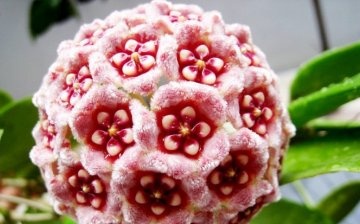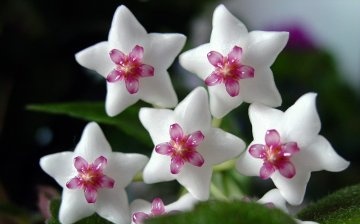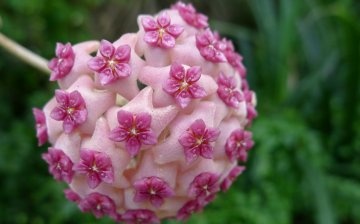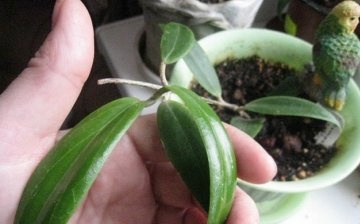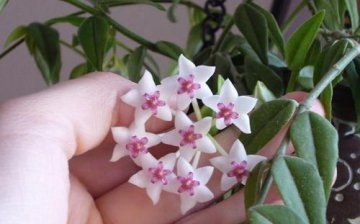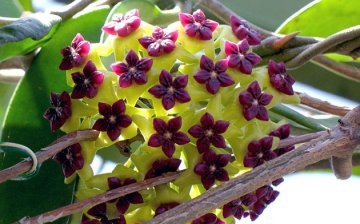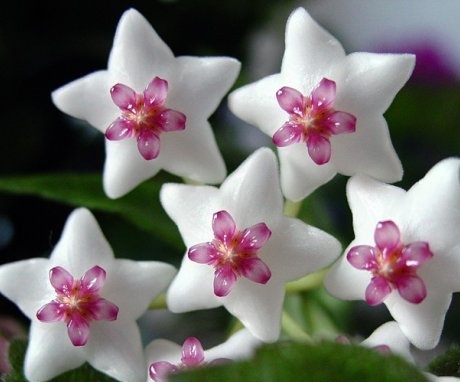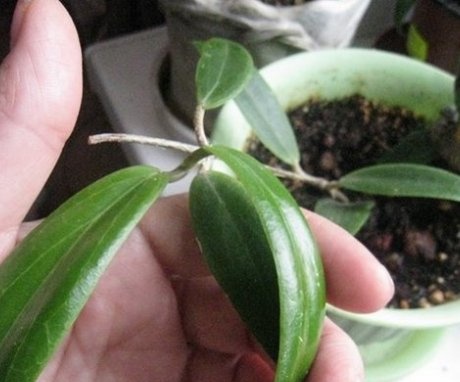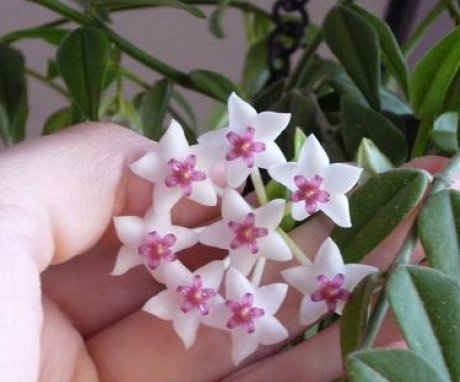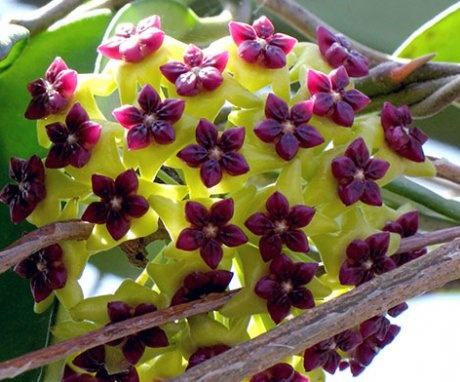Hoya flower - evergreen tropical beauty for your interior
Botanists discovered the original and attractive hoya flower back in the 18th century, when they landed on the shores of Australia on the ship of James Cook. A little later, several representatives of this species were discovered on the shores of the Malay Archipelago, in the forests of India and Papua New Guinea. And the name was given to him in honor of the English breeder Hoy, who managed to cultivate him.
Content:
- Types and description of the flower
- Growing conditions
- Plant propagation
- Hoya care tips
- Pests and diseases: control and prevention
Types and description of the flower
In its homeland, hoya grows in places where trees are found only occasionally and which are well lit by the sun. The plant loves moist soils and prefers, as it belongs to the family lianas, next to a powerful tree or rocky ledge, which you can grab onto and grow up.
The length of the hoya sometimes reaches 10 meters.
But she is attracted by white, star-like, tiny flowers collected in small bouquets. At the same time, a strong smell that attracts insects is felt several meters away, but the sap of the plant can irritate the mucous membranes. The branches of the plant are covered with fleshy oblong leaves. Over time, and thanks to the efforts of gardeners, the flower has turned into a cultivated plant and can decorate both the premises of the house and the area around it.
The most famous plant species are the following:
- You can meet with Hoya Kerry in Thailand, China, on the island of Java, thick leaves that look like a heart give it uniqueness, and not cream flowers that are miniature a centimeter in diameter. This species loves warmth, light and does not tolerate dampness. Kerry's only drawback is her long growth.
- At the beginning of the 19th century, wax ivy, or fleshy Hoya, appeared in the rooms of European houses, unpretentious, pleasing flowering three times a year. It is with its white-pink flowers with a burgundy corolla in the middle that this liana-like plant attracts.
- The Karnoza variety was brought from Japan, Taiwan and Australia, which is an excellent honey plant and has white inflorescences with a pink tint. In the summer, this species can be transplanted into the garden, and in the winter it can be brought indoors.
- Java Island presented such a wonderful Hoya Bella with pure white flowers.
- But Hoya Multiflorous blooms from the first year of planting, and the shape of the flowers resembles stars, the middle of which is crowned with a crown similar to the tip of a spear or arrow.
- The Imperial Hoya is characterized by the largest flowers of this genus with a diameter of eight centimeters in a beautiful pink-red tone.
There are about two hundred varieties of hoya flower, and each grower will be able to choose the one he likes most.
Growing conditions
To grow a flower at home, you need to pay attention to what kind of soil substrate will be ideal for it. Usually they use sod land with the addition of sand, peat, crushed bark and moss, which will help to retain moisture and prevent the hoya from drying out.
Considering that the plant is tropical, it cannot be overcooled. Optimal for him is 23-25 degrees above zero.The room where the hoya is located must be constantly ventilated so that the air is not stale, but it is better to avoid drafts. Even in winter, you need to monitor the temperature drop in the room. Already at positive 12 degrees, the plant may feel bad, and as a symptom of this - yellowed or falling leaves.
Although hoya is unpretentious, if there is not enough light, then it will not please with flowering.
But she is also afraid of direct sunlight: the luminary can severely burn the leaves of the flower. The best direction of the window where the plant should be located is east or west. For comfort, the flower also needs long-term illumination for 14 hours, therefore, in winter, if there is a shortage of it, the inclusion of additional lamps is mandatory.
Hoya begins to bloom upon reaching the shoots of at least 30 centimeters in length, and then it is necessary for her to create comfortable conditions. She especially does not like permutations from place to place, otherwise both formed buds and blossoming flowers are threatened with falling off. Many of the species of this plant have weak long stems, so do not forget about the supports for them.
Plant propagation
The off-season is good for flower reproduction, which is produced cuttings... For this action:
- Last year's shoots with several pairs of nodes and leaves are taken from the tops.
- Cut off the selected branches just below the node and root them in a prepared substrate, for which sand or peat mixed with it is suitable with the addition of phytohormones to improve root formation and growth. Some root by dropping the cutting into a container of water.
The method of propagation by layering for hoya is also suitable. For this:
- In March, a branch of creepers is placed on another pot with prepared soil.
- They cut it at the point of contact with the soil, drop it in, cover it with moss and fix it with a stone or wooden hairpin, then wrapping it with plastic wrap.
- As soon as a young shoot appears, the mother branch is removed. After a while, the layers are transplanted into a new container.
- Only after the roots appear, the plant is transplanted to a permanent place of residence in a not too large pot, otherwise the roots will develop rapidly, impairing the process flowering.
Seeds Hoya is also bred, but for this they must be fresh. The appearance of the first shoots, which is a thin stalk with a pair of leaves, occurs quickly. And then a special one is needed for them. careprotecting them from death: keeping the shoots in a warm, well-lit room using regular glaze... When strengthening after about 3 months root system you need to transplant a young plant into a separate pot.
Hoya care tips
Regular watering important for a tropical flower, it should be especially abundant in spring and summer. Here, the main thing is not to let the soil dry out, leaving it slightly moist, but it is not recommended to fill it too much. Spraying hoya leaves are carried out no more than two to three times a week, but it is contraindicated for flowers and buds.
If the leaves on the plant turn yellow, then the soil needs to dry out, and the plant should not be sprayed at all. The yellow leaves are removed, and the flower is added mineral fertilizers.
Flower feeding:
- Before feeding a plant, you need to find out everything about its homeland and favorable soil for it. A flower growing on mosses is hostile to feedingcontaining calcium, but the inhabitant of the river bank, strewn with shell rock, on the contrary, is tied to such dishes.
- With slow growth of hoya, fertilizing with nitrogen is necessary fertilizers and spraying with Epin growth stimulant.
- Having picked up the right additional food, you do not need to overfeed them with hoya, it's like a person's - a feeling of slight hunger is better than health problems.
Transplant young hoya is better annually, but for adult plants it is enough to do this every three years from spring to the first month of autumn. For this procedure, a pot is preliminarily prepared, preferably ceramic, with specially prepared soil: easily permeable, nutritious, preferably neutral or slightly acidic. Before filling the flowerpot with earth, do not forget about the drainage layer, which fills the container by a third.
Another condition for the harmonious development of an exotic plant is regular pruning too long lashes.
This will stimulate the formation of new lateral shoots and the flower will become more lush from this. The top of the hoya is pinched after the formation of the fourth leaf. The peculiarity of the plant is that the hemp of fallen inflorescences is by no means recommended to be removed, since next year they will be used as a basis for new fragrant flowers. Unpretentious care speaks in favor of choosing a hoya flower to decorate rooms at home or office.
Pests and diseases: control and prevention
Improper plant care will lead to plant diseases, which can manifest itself in the form of yellowness and improper development of the leaves. In order to prevent sores in the plant, it is necessary to water it with the water in which it was cooked potatoes... It will help the flower become more resilient, stronger and protect itself from various misfortunes.
Hoya's diseases include the following:
- When plaque appears on the leaves, both black and white, we can confidently talk about the defeat of the flower by spores of the fungus.
- Infectious diseases are manifested by symptoms of rot, wilting or the appearance of spots on the leaves. For treatment, the leaves must be wiped with soapy water followed by processing fungicidal drug. A solution of laundry soap with copper sulfate is also effective.
- The appearance of mold on the leaves and on the soil in pots indicates either frequent watering or the use of too hard water for this. To solve the problem, remove the top affected soil layer and add fresh soil. And it is more efficient to implement transplant plants with subsequent disinfection of the pot with a solution of vinegar and water. To soften the irrigation water, peat wrapped in gauze (one hundred grams per two liters of water) is dipped into it for a day in advance.
- Increased humidity leads to the formation powdery mildew, from which you can get rid of the drugs Tiovit, Quadris SK or copper oxychloride.
Of the pests, the hoya is most affected by the scabbard, which sucks the juice from the leaves and stem of the flower. It is simple to deal with it: collect an insect from the leaves, and rinse the plant itself first with soapy water, then clean warm. Pest The cherven is removed from the leaves and stem with a cotton swab dipped in an alcohol solution.
For the root system of the plant, nematodes, transparent worms that destroy the base of the flower, pose a threat.
In case of defeat, it is necessary to rinse the hoya roots with warm water, and then treat with insecticidal preparations. For preventive purposes, it is good to regularly carry out the procedure for washing the flower with an infusion of onions or garlic, then the pests are not terrible. By properly caring for the plant, problems in growth and flowering can be avoided.
More information can be found in the video.



